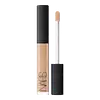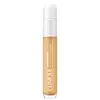What's inside
What's inside
 Key Ingredients
Key Ingredients

 Benefits
Benefits

 Concerns
Concerns

 Ingredients Side-by-side
Ingredients Side-by-side

Water
Skin ConditioningDimethicone
EmollientHydrogenated Polydecene
EmollientPropanediol
SolventButylene Glycol
HumectantPEG-9 Polydimethylsiloxyethyl Dimethicone
EmulsifyingGlycerin
HumectantDisteardimonium Hectorite
StabilisingPEG-10 Dimethicone
Skin ConditioningPolymethyl Methacrylate
Bis-Butyldimethicone Polyglyceryl-3
CleansingSorbitan Sesquiisostearate
EmulsifyingDimethicone/Vinyl Dimethicone Crosspolymer
Skin ConditioningPhenoxyethanol
PreservativeIsostearic Acid
CleansingPolysilicone-2
Aluminum Hydroxide
EmollientMaltodextrin
AbsorbentTrisodium EDTA
Lecithin
EmollientSilica
AbrasiveTin Oxide
AbrasiveTriethoxycaprylylsilane
Tocopheryl Acetate
AntioxidantSodium Metabisulfite
AntioxidantMagnolia Officinalis Bark Extract
AntimicrobialTocopherol
AntioxidantVitis Vinifera Seed Extract
AntimicrobialMica
Cosmetic ColorantCI 77891
Cosmetic ColorantCI 77491
Cosmetic ColorantCI 77492
Cosmetic ColorantCI 77499
Cosmetic ColorantCI 77163
Cosmetic ColorantCI 42090
Cosmetic ColorantWater, Dimethicone, Hydrogenated Polydecene, Propanediol, Butylene Glycol, PEG-9 Polydimethylsiloxyethyl Dimethicone, Glycerin, Disteardimonium Hectorite, PEG-10 Dimethicone, Polymethyl Methacrylate, Bis-Butyldimethicone Polyglyceryl-3, Sorbitan Sesquiisostearate, Dimethicone/Vinyl Dimethicone Crosspolymer, Phenoxyethanol, Isostearic Acid, Polysilicone-2, Aluminum Hydroxide, Maltodextrin, Trisodium EDTA, Lecithin, Silica, Tin Oxide, Triethoxycaprylylsilane, Tocopheryl Acetate, Sodium Metabisulfite, Magnolia Officinalis Bark Extract, Tocopherol, Vitis Vinifera Seed Extract, Mica, CI 77891, CI 77491, CI 77492, CI 77499, CI 77163, CI 42090
Water
Skin ConditioningMethyl Trimethicone
Skin ConditioningTrimethylsiloxysilicate
EmollientDimethicone
EmollientButylene Glycol
HumectantPhenyl Trimethicone
Skin ConditioningNeopentyl Glycol Diheptanoate
EmollientNiacinamide
SmoothingHydroxyethyl Urea
HumectantLauryl PEG-9 Polydimethylsiloxyethyl Dimethicone
Skin ConditioningGlycerin
HumectantSodium Polyaspartate
HumectantAscorbyl Glucoside
AntioxidantCaffeine
Skin ConditioningPhytosphingosine
Skin ConditioningMagnesium Ascorbyl Phosphate
AntioxidantResveratrol
AntioxidantSodium Hyaluronate
HumectantPolygonum Cuspidatum Root Extract
AntioxidantAcetyl Hexapeptide-8
HumectantPalmitoyl Hexapeptide-12
Skin ConditioningTocopheryl Acetate
AntioxidantTetrahexyldecyl Ascorbate
AntioxidantSalicylic Acid
MaskingSigesbeckia Orientalis Extract
Skin ConditioningCaprylyl Glycol
EmollientTrihydroxystearin
Skin ConditioningTriethyl Citrate
MaskingPPG-15 Stearyl Ether
EmollientPEG-10 Dimethicone
Skin ConditioningSorbitol
HumectantTrehalose
HumectantMicrococcus Lysate
Skin ConditioningIsopropyl Isostearate
EmollientLecithin
EmollientZinc Stearate
Cosmetic ColorantDimethicone/PEG-10/15 Crosspolymer
Alumina
AbrasiveTriethoxycaprylylsilane
Silica
AbrasiveGlyceryl Polymethacrylate
Laureth-7
EmulsifyingMagnesium Aluminum Silicate
AbsorbentHexylene Glycol
EmulsifyingPEG-8
HumectantDisteardimonium Hectorite
StabilisingPropylene Glycol Caprylate
Skin ConditioningVinyl Dimethicone/Methicone Silsesquioxane Crosspolymer
Polysilicone-11
Sodium Hydroxide
BufferingXanthan Gum
EmulsifyingSodium Chloride
MaskingCitric Acid
BufferingAmmonium Acryloyldimethyltaurate/Vp Copolymer
Dipropylene Glycol
HumectantBHT
AntioxidantDisodium EDTA
Sodium Citrate
BufferingPotassium Sorbate
PreservativePhenoxyethanol
PreservativeMica
Cosmetic ColorantCI 77891
Cosmetic ColorantCI 77491
Cosmetic ColorantCI 77492
Cosmetic ColorantCI 77499
Cosmetic ColorantCI 77163
Cosmetic ColorantWater, Methyl Trimethicone, Trimethylsiloxysilicate, Dimethicone, Butylene Glycol, Phenyl Trimethicone, Neopentyl Glycol Diheptanoate, Niacinamide, Hydroxyethyl Urea, Lauryl PEG-9 Polydimethylsiloxyethyl Dimethicone, Glycerin, Sodium Polyaspartate, Ascorbyl Glucoside, Caffeine, Phytosphingosine, Magnesium Ascorbyl Phosphate, Resveratrol, Sodium Hyaluronate, Polygonum Cuspidatum Root Extract, Acetyl Hexapeptide-8, Palmitoyl Hexapeptide-12, Tocopheryl Acetate, Tetrahexyldecyl Ascorbate, Salicylic Acid, Sigesbeckia Orientalis Extract, Caprylyl Glycol, Trihydroxystearin, Triethyl Citrate, PPG-15 Stearyl Ether, PEG-10 Dimethicone, Sorbitol, Trehalose, Micrococcus Lysate, Isopropyl Isostearate, Lecithin, Zinc Stearate, Dimethicone/PEG-10/15 Crosspolymer, Alumina, Triethoxycaprylylsilane, Silica, Glyceryl Polymethacrylate, Laureth-7, Magnesium Aluminum Silicate, Hexylene Glycol, PEG-8, Disteardimonium Hectorite, Propylene Glycol Caprylate, Vinyl Dimethicone/Methicone Silsesquioxane Crosspolymer, Polysilicone-11, Sodium Hydroxide, Xanthan Gum, Sodium Chloride, Citric Acid, Ammonium Acryloyldimethyltaurate/Vp Copolymer, Dipropylene Glycol, BHT, Disodium EDTA, Sodium Citrate, Potassium Sorbate, Phenoxyethanol, Mica, CI 77891, CI 77491, CI 77492, CI 77499, CI 77163
 Reviews
Reviews

Alternatives
Ingredients Explained
These ingredients are found in both products.
Ingredients higher up in an ingredient list are typically present in a larger amount.
Butylene Glycol (or BG) is used within cosmetic products for a few different reasons:
Overall, Butylene Glycol is a safe and well-rounded ingredient that works well with other ingredients.
Though this ingredient works well with most skin types, some people with sensitive skin may experience a reaction such as allergic rashes, closed comedones, or itchiness.
Learn more about Butylene GlycolThis synthetic powder is used to add a pearly/white color in cosmetics.
Ci 77491 is also hydrated iron III oxide. It's sole purpose is to give a red/pink hue to products.
Iron III oxides are classified as inorganic chemicals for coloring.
Synthetically created Ci 77491 is considered safer than those naturally found. This is because the synthetically created version may contain less impurities. Iron oxides are generally non-toxic and non-allergenic.
Learn more about CI 77491Ci 77492 is also hydrated iron III oxide. It's sole purpose is to give a yellow hue to products.
Iron III oxides are classified as inorganic chemicals for coloring.
Synthetically created Ci 77492 is considered safer than those naturally found. This is because the synthetically created version may contain less impurities. Iron oxides are generally non-toxic and non-allergenic.
Learn more about CI 77492Ci 77499 is also hydrated iron III oxide. It is created from mixing red and black iron oxides. This helps give shades of darkness to a product.
Iron III oxides are classified as inorganic chemicals for coloring.
Ci 77891 is a white pigment from Titanium dioxide. It is naturally found in minerals such as rutile and ilmenite.
It's main function is to add a white color to cosmetics. It can also be mixed with other colors to create different shades.
Ci 77891 is commonly found in sunscreens due to its ability to block UV rays.
Learn more about CI 77891Dimethicone is a type of synthetic silicone created from natural materials such as quartz.
What it does:
Dimethicone comes in different viscosities:
Depending on the viscosity, dimethicone has different properties.
Ingredients lists don't always show which type is used, so we recommend reaching out to the brand if you have questions about the viscosity.
This ingredient is unlikely to cause irritation because it does not get absorbed into skin. However, people with silicone allergies should be careful about using this ingredient.
Note: Dimethicone may contribute to pilling. This is because it is not oil or water soluble, so pilling may occur when layered with products. When mixed with heavy oils in a formula, the outcome is also quite greasy.
Learn more about DimethiconeDisteardimonium Hectorite comes from the clay mineral named hectorite. It is used to add thickness to a product.
It can also help stabilize a product by helping to disperse other ingredients.
Hectorite is a rare, white clay mineral.
Learn more about Disteardimonium HectoriteGlycerin is already naturally found in your skin. It helps moisturize and protect your skin.
A study from 2016 found glycerin to be more effective as a humectant than AHAs and hyaluronic acid.
As a humectant, it helps the skin stay hydrated by pulling moisture to your skin. The low molecular weight of glycerin allows it to pull moisture into the deeper layers of your skin.
Hydrated skin improves your skin barrier; Your skin barrier helps protect against irritants and bacteria.
Glycerin has also been found to have antimicrobial and antiviral properties. Due to these properties, glycerin is often used in wound and burn treatments.
In cosmetics, glycerin is usually derived from plants such as soybean or palm. However, it can also be sourced from animals, such as tallow or animal fat.
This ingredient is organic, colorless, odorless, and non-toxic.
Glycerin is the name for this ingredient in American English. British English uses Glycerol/Glycerine.
Learn more about GlycerinLecithin is a term for a group of substances found in the cell membranes of plants, animals, and humans. They are made up of mixture of phospholipids.
This ingredient has emollient and emulsifying properties.
As an emollient, lecithen helps soften the skin and creates a barrier to keep moisture in.
As an emulsifier, it also helps prevent water and oil ingredients from separating. Lecithin can also help ingredients be better absorbed by the skin.
This is because the phospholipids in lecithin produce liposomes. Liposomes help other ingredients get through the skin barrier.
Depending on the source of this ingredient, lecithin may not be fungal acne safe. This is because some sources of lecithin come from soybean oil, which may feed the malassezia yeast that feeds fungal acne.
We recommend reaching out to the brand you are purchasing from to inquire about the source of their lecithin.
Some other names for this ingredient include soy lecithin and deoiled soy lecithin.
Learn more about LecithinMica is a naturally occurring mineral used to add shimmer and color in cosmetics. It can also help improve the texture of a product or give it an opaque, white/silver color.
Serecite is the name for very fine but ragged grains of mica.
This ingredient is often coated with metal oxides like titanium dioxide. Trace amounts of heavy metals may be found in mica, but these metals are not harmful in our personal products.
Mica has been used since prehistoric times throughout the world. Ancient Egyptian, Indian, Greek, Roman, Aztec, and Chinese civilizations have used mica.
Learn more about MicaPeg-10 Dimethicone is silicone with conditioner and emulsifier properties. It mostly acts as an emollient in skincare and and humectant in haircare.
According to the manufacturer, acidic formulations decrease the stability of this ingredient. It works best in neutral or near neutral formulations.
Phenoxyethanol is a preservative that has germicide, antimicrobial, and aromatic properties. Studies show that phenoxyethanol can prevent microbial growth. By itself, it has a scent that is similar to that of a rose.
It's often used in formulations along with Caprylyl Glycol to preserve the shelf life of products.
Silica, also known as silicon dioxide, is a naturally occurring mineral. It is used as a fine, spherical, and porous powder in cosmetics.
Though it has exfoliant properties, the function of silica varies depending on the product.
The unique structure of silica enhances the spreadability and adds smoothness, making it a great texture enhancer.
It is also used as an active carrier, emulsifier, and mattifier due to its ability to absorb excess oil.
In some products, tiny microneedles called spicules are made from silica or hydrolyzed sponge. When you rub them in, they lightly polish away dead skin layers and enhance the penetration of active ingredients.
Learn more about SilicaTocopheryl Acetate is AKA Vitamin E. It is an antioxidant and protects your skin from free radicals. Free radicals damage the skin by breaking down collagen.
One study found using Tocopheryl Acetate with Vitamin C decreased the number of sunburned cells.
Tocopheryl Acetate is commonly found in both skincare and dietary supplements.
Learn more about Tocopheryl AcetateTriethoxycaprylylsilane is a silicone used to bind and stabilize ingredients.
As an emulsifier, it helps prevent ingredients from separating. This can help elongate the shelf life of products.
Triethoxycaprylylsilane is often used to coat mineral sunscreens ingredients to help give a better feel. It also helps reduce oxidative stress in sunscreens.
Learn more about TriethoxycaprylylsilaneWater. It's the most common cosmetic ingredient of all. You'll usually see it at the top of ingredient lists, meaning that it makes up the largest part of the product.
So why is it so popular? Water most often acts as a solvent - this means that it helps dissolve other ingredients into the formulation.
You'll also recognize water as that liquid we all need to stay alive. If you see this, drink a glass of water. Stay hydrated!
Learn more about Water